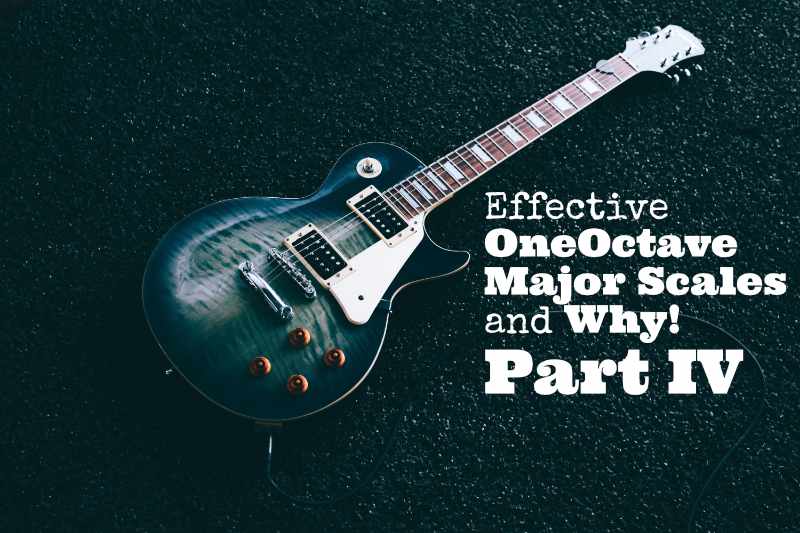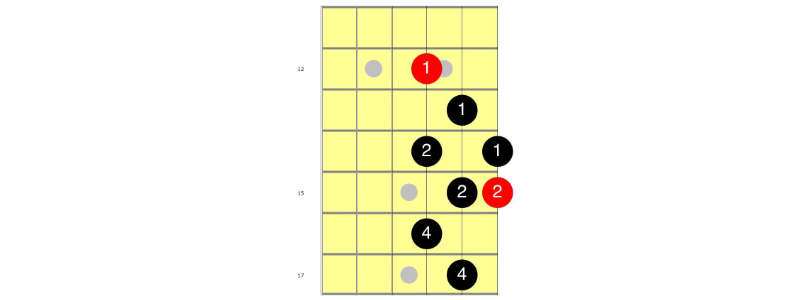November 5, 2020 by Klaus Crow

Hi folks, I know you’ve been waiting eagerly, and your patience is rewarded. Here it is: Part IV of the Effective One-Octave Major Scales! This is the final lesson of these series and if you haven’t had the chance to dive into Part I, II & III and you don’t know why you should, I recommend that you check them out. Here are the links below:
Effective One-Octave Major Scales and Why! Part I
Effective One-Octave Major Scales and Why!Part II
Effective OneOctave Major Scales and Why!Part III
With Part IV of the lesson we are really getting into the area where most of the guitar solos take place. Take your time with these 3 major scale patterns. Learn and memorize them thoroughly. Don’t half ass it!
Starting from the Root Note on the G-string
We’re now going to learn the three major scale shape/patterns with the first (root) note starting on the G-string (3rd string).
Tip: Learn and memorize the notes on the G-string so you know where you are on the fretboard. Know your notes!
Major Scale Fingering / Positioning
The numbers in the yellow neck diagrams indicate the fret-hand fingering. The neck diagrams clearly show the shape and pattern of each scale. Learn to visualize and memorize the shape of each pattern.
| 1 = index | 2 = middle finger |3 = ring finger | 4 = pinky |
Practice, practice, practice!
Once you got the G major scale shapes thoroughly under your fingers learn the pattern in different keys. If you know how to play the scale somewhere on the neck doesn’t neccesarily mean you can play it everywhere else. Practice the scale all over the neck! Go the extra mile.
Take this moment to invest in yourself. Pour yourself a nice cup of coffee or tea, find a descent chair, sit straight and makes sure you have proper posture and hand positioning, set a timer to 30 or 60 minutes, own this time, focus, practice and enjoy!
MAJOR SCALE SHAPES – ROOT NOTE STARTS FROM THE 3RD STRING
G MAJOR SCALE fingering / shape / pattern #10


G MAJOR SCALE fingering / shape / pattern #11


G MAJOR SCALE fingering / shape / pattern #12


Assignments:
- Vividly memorize the shape and the fingering of each scale pattern.
- Learn and memorize all the notes on the fretboard so you know the key of the scale when you move the scale shape/pattern up or down the neck.
- Memorize where the root notes are located.
- Learn the one-octave major scale shapes in different keys.
- Play the scales along with a metronome gradually increasing the bpm.
- Re-practice the one-octave major scale patterns of Part I, II & III.
- Try to create some melody and learn to solo with the scale patterns over a major scale chord progression.
- Bonus Intermediate/Advanced Assignment: Call out the note name of each note where your finger lands while you play the scale. G major scale: G – A – B – C – D – E – F# – G. Do this exercise in all 12 keys.
How did you do so far? Where are you on the path? What are your struggles? Do you like these lessons? Please share your comments below. I always respond. Thanks, I appreciate it. -Klaus Crow
Good day Klaus. Thanks, I was indeed eagerly waiting for this. ?
Barry
Hi Barry,
Haha, I thought so ;) Enjoy the lesson. It’s a great one!
Best,
Klaus Crow
This lesson is by far the best and easiest part of the series. Thanks for all the good work.
Ingrid
Hi Ingrid,
Thanks. I appreciate that. You’ll get a lot out of it.
These lessons are really good for you.
Have a good practice!
Best,
Klaus
Klaus I really enjoyed your series of lessons on the major scale octave patterns. It really expanded the fretboard! I wondered if you had or were planning something similar for the Minor scales? ! Or I was wondering if I can apply the pentatonic trick( I hate that use of the word) and start with the note opposite of the major root. As you might have guessed, I have not put a lot of thought into this myself and hope you do not think I am “dumping” on you.:-)
Hi John,
That’s a good idea. I will also do a one-octave lesson with the natural minor scale sometime.
If you want to play the major pentatonic scale just leave out the 4th and the 7th note of all the patterns in these series and you’ll end up with the major pentatonic.
If you want to play minor pentatonic you have to play 1 – b3 – 4 -5 – b7 notes of the major scale and you’ll end up with the minor pentatonic and you can apply that to all the patterns of these series as well.
I hope that makes sense.
Best,
Klaus Crow